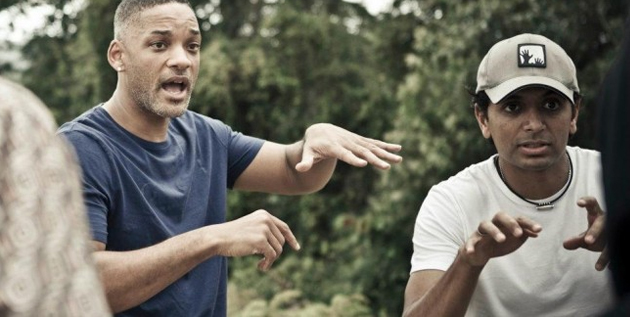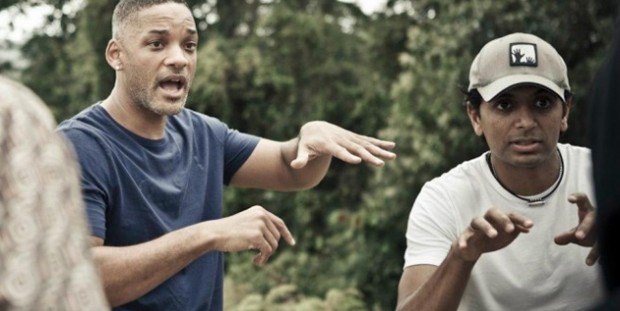
What foremost seems to unite the films of M. Night Shyamalan are belief and, to a more personal extent, faith. Due to their frequent toiling with the supernatural, that seems a given: belief and faith are simply a natural part of such narratives, in their application forcing the protagonist to overcome an initial skepticism — both as an arc and a means of grounding silly concepts in something resembling reality. Yet Shyamalan’s films dig deeper than just that, making these intertwined facets essential as in his favored conflict between emotions and rationality.
It’s a compelling, rightfully applied idea that many overlook in favor of simply scorning his works, nearly all of them open-heart attempts to display dependency and understanding as two connected pieces each of a different color. With his new film, After Earth, opening on Friday, we’ve decided to look at Shyamalan’s career from this perspective, in doing so hoping to expose maligned pictures for their true strength.
Note: Due to its seemingly complete unavailability, his first feature, Praying With Anger, will not be discussed.
Wide Awake (1998)
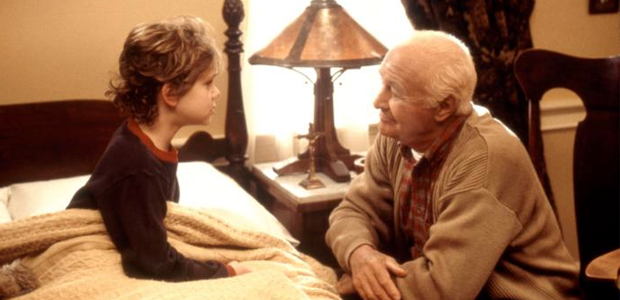
Shyamalan’s little-seen, little-acknowledged, not-really debut (check note above), while absent of the genre classification that’s instantly noted with his name, is still certainly a forebearer of many narrative obsessions.
Faith/belief is at its most overt here as a fifth-grader looks for God after the death of his grandfather (played by Robert Loggia, of all people). A spiritual crisis for a ten-year-old instantly seems rather strained, but it makes sense upon noticing the exact child at Wide Awake‘s center, one who’s essentially in the limbo of precociousness: containing knowledge but not having enough experience to properly apply it.
Seen through the flashbacks of his grandfather — as well as interactions with caring, if too preoccupied parents — death comes with natural acceptance from adults, but is always one of the initial steps in creating doubt, even disbelief in youth. Though, as previously mentioned, the “genre” elements are absent here, God as an invisible force trying to be grappled with throughout is certainly in line with the ghosts, threat of wood-monsters, and killer air found in his filmography; it’s the deviation from a spooky sense of place that makes this an even more fascinating item in his filmography.
Despite a clear three-act structure — enabled by title cards informing the months and their corresponding step in the child’s quest (seemingly an omen of the act of storytelling being very upfront in his work) — the film’s flaws show in its mostly episodic nature, seeming to repeat its questions of belief rather than have a distinct vertical development. But, at the very least, Shyamalan’s sensitivity is still very apparent, and will find itself only developing once his further titles adopt genre mechanics.
The Sixth Sense (1999)
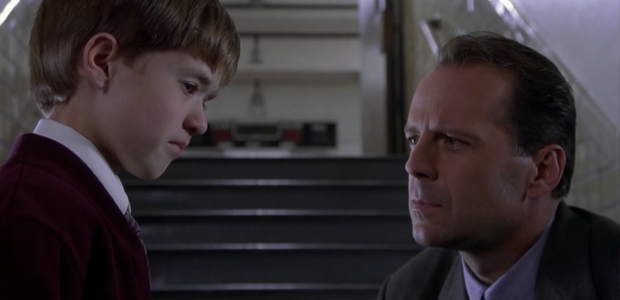
What seems to be truly overlooked about Shyamalan’s second feature, still his most popular, are the particulars of Bruce Willis’ role as child psychiatrist Malcolm Crowe — in short, how he’s essentially a bullshit artist. The film’s opening, unanimously considered the “set up the twist” part, actually reveals something much different and far more important.
Consider that Crowe is being rewarded for work that we, the audience, never actually see any of. As he and his wife’s reflection are cast in a trophy, they drink champagne and he basks in a seemingly unearned glory. Yet, when confronted with a former patient who wants “what was promised” to him, he instantly launches into an act — calming his voice, faux-sympathetically arching his eyes and asserting him that he was “very smart and unusually compassionate.” It’s a facileness to which Donnie Wahlberg‘s character is instantly used to, and violently reacts against.
In building off his last film, the child-adult relationship comes more directly to the forefront because, if anything, the afterlife for Crowe is an enforced atonement — and on a path of inevitable belief, his only company in the world is a child.
While the previous work didn’t show what was by any means a technical slouch, it’s in The Sixth Sense that Shyamalan announced himself as a formalist, one seemingly under the guise of genre requiring certain flourishes. (Many of his choices border on ostentatious, be it frequent camera movements or oft-mentioned red color motif.) In a way, he comes off as a combination of Hitchcock and Spielberg: a desexualized master of suspense.
Unbreakable (2000)
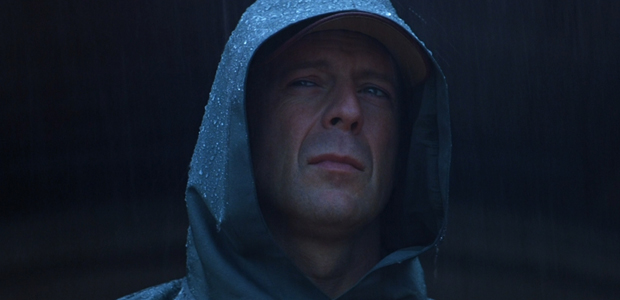
Shyamalan’s next feature — coming before the comic book film dominated international markets and somewhat validated a “geek is cool” cultural mantra — continues to show a conflict between belief and skepticism. In this case, belief’s danger is seen in Elijah (Samuel L. Jackson), who takes fanboyism to the level of religious fundamentalism, constantly affirming the pop storytelling of comic books as not vulgarity but a mirror to the world. This is best noted in one of the film’s more amusing scenes, as he angrily argues for the artistic merit of an original comic book sketch, remarking to a clueless dad that this is in fact an art gallery and not a toy store.
But pop served with the portentous further extends to Unbreakable as a whole. Shyamalan is continually trying to elevate its comic book origin story with even more carefully planned camera movements and symbolic colors, as well as further proof of his Spielberg inheritance in the somber family drama involving separation and, his clear favorite, emotionally confused children.
Still, the mirroring of Shyamalan and Elijah’s beliefs comes into sharper focus with its source of skepticism: Bruce Willis‘ David. There seems to often be a distance between the camera and him, a space that gives the sense of one uncomfortable in their own life, and furthermore in accepting his gift / greater role.
Though he ultimately does so as the hero, David moves towards Shyamalan’s side, accepting the fantastical while accepting it as something that couldn’t possibly be explained in full. This exemplifies why Elijah is his arch-nemesis: he sees it all as a reaffirmation that he’s “not a mistake” — that essentially everything lines up into a rigorous order, or can somehow be explained.
Signs (2002)

As with Wide Awake, belief finds itself very blatantly manifested in Signs‘ religious surfaces. As a former reverend, Graham Hess (Mel Gibson), who lost his faith over the death of his wife, must confront otherworldly events that challenge his new notions of a cruel, random reality. Hess, however, comes off as the only real adult at the center of the film’s narrative, despite his brother, Merill, wonderfully played by Joaquin Phoenix, often awkwardly trying to fit some patriarchal role — seen best when frequently reassuring his niece and nephew about “the nerds” behind recent phenomena.
Upon mentioning this, one can sense Shyamalan laying the seeds of The Happening, well represented in both Phoenix’s character and performance, these marking a clear predecessor to Mark Wahlberg’s goofball; really, there are equal levels of believability in their respective roles as former professional athlete and high-school science teacher.
Yet he, along with the other members that form this family unit, is essentially isolated through rural living, managing to receive information primarily from their television. The newscasts are met with initial skepticism from both the family and townfolk (a bookshop owner is convinced it’s a marketing ploy to sell soda). Eventually, though, they become a form of complete fixation, which in turn — with the son Morgan’s alien textbook (coincidentally showing a home resembling theirs being decimated) and the signal picked up from a baby monitor — show a narrative assembling out of everyday pieces, a family gathering around said pieces as if they were a new bible.
It becomes something that Hess cannot avoid, which is why the aliens’ eventual physical manifestation is a double-edged sword: proving that, occasionally, something is both as simple as it initially seems, yet also showing that faith can be resurrected through the unexplainable.
The Village (2004)
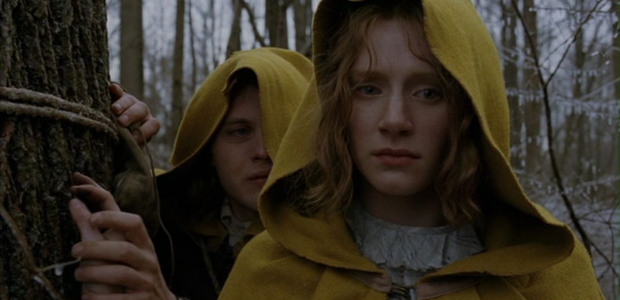
Many like to frame Shyamalan’s 2004 feature as a post-9/11 allegory — the Bush’s administration’s color-coded threat-levels being seen in the elder’s warnings of red as the forbidden color (yellow being a safe one). This is not at all invalid, but The Village has much more on its mind: cinema itself.
While seemingly recycling one of The Sixth Sense’s key visual motifs, Shyamalan appears to be fully aware of his own belief in the power of color, the components of visual storytelling, or rather a “pure cinema.” This finds itself manifested in a simulation of a 19th-century setting. After all, words need images to compliment them; the village itself is the skeleton of a film, but colors are the mise-en-scène, so to speak. As storytelling was exemplified in his past films through school plays, comic books, and television broadcasts, it comes to its clearest point here, rendered through every step of a developing narrative.
As with Unbreakable, though, the pursuit of a storytelling manifested in reality is revealed to be steeped in the most dangerous forms of righteousness, and the construct of the village is entrapment instead of escape. Even its intended safety from the real world is built upon a contradiction: it relies on the foundation of fear, holding inhabitants in a form of arrested development.
In its climax, the construction eventually collapses because one figure navigates around her fear though love, instead of succumbing to it the way she’d always been taught. That she’s blind is, perhaps, too perfect: this disability makes her insusceptible to a dominant visual language.
Lady in the Water (2006)
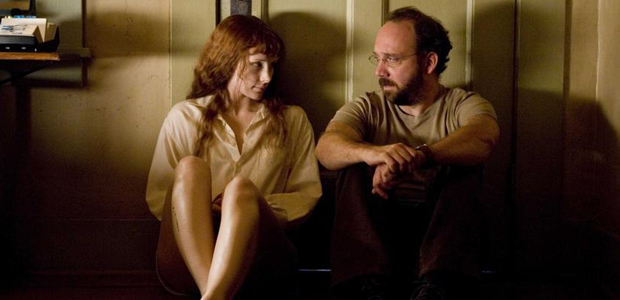
Skepticism finds itself least present in his 2006 feature, though certainly inviting it to the viewer while shutting out its characters. (Save for one naysayer, the… film critic).
Lady in the Water contains the most idealized of all his settings, as disbelief is almost completely absent, save for the aforementioned critic: a place in which everyone can easily agree to contribute to a greater cause, in this case the story, or literal Story, the name of the titular “Narf” played by Bryce Dallas Howard. Because it does not place in any discernible reality, the film runs not a risk humanism but naïveté, and yet this apartment complex — full of caricatures defined by either some physical quirk or stereotype — serve as part of the film’s greater point: storytelling’s idealization in exaggeration.
Most seem to laugh at the sight of Paul Giamatti curling up on a couch with milk and cookies to be read a bedtime story, or a young boy finding the secrets to saving the day in cereal boxes, or even the frequent utterance of “Narf” and “Scrunt.” But the instant cynicism it seems to arouse says more about a particular viewer than the film itself; a mirror is raised towards you, and Shyamalan finally asks “Is it you who believes? If not, why can’t you?”
While Shyamalan still manages to bury any possible didacticism — or, rather, confrontation — well underneath his narrative, casting himself as the genius writer for whom everyone is relying on to finish his masterpiece may have been a mistake, both in that it instantly removes any sense of him as “a humble artist,” as well as the matter of him being, frankly, not the strongest thespian. But like the rest of the film and, like the rest of his career, this writer at least admires the of-a-piece conviction that comes with it.
The Happening (2008)
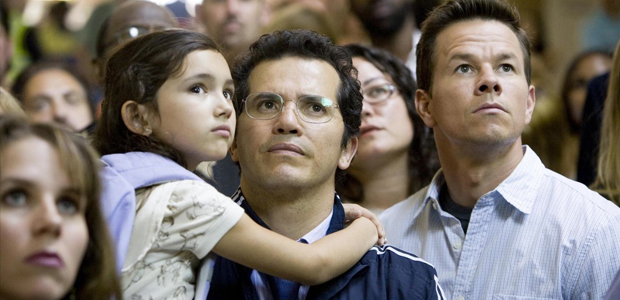
Inspiring what would likely seem to be the peak of scorn for his films (well, at least until the next one) due to its intense stylization of tone and performance, The Happening argues for more emotional rather than statistical logic, which Shyamalan had seemingly grappled with throughout his career.
While an adult couple, its two main characters — Elliot (Mark Wahlberg) and Alma (Zooey Deschanel) — are barely deserving of that title, for throughout they come off as children with their high voices, exaggerated facial expressions, and generally immature mood swings. They’re beings of unrestrained emotion cast into chaos, trying to operate through pre-established intellectual codes; it’s best represented by the sequence in which Elliot is indecisive in the face of a mass suicide surrounding him. He’s constantly being yelled at to do something, but only able to resort to science, hiding behind facts and equations in a state of panic.
Their infantile state is further threatened when thrown into a parental role, taking the daughter of their friend, Julian. At this trade, he asks her not to take the girl “unless you mean it,” which is followed by a close-up on Deschanel’s bluer-than-the-sea eyes as she attempts to comprehend an actual adult’s plea to please grow up.
Like in Signs, both exposition and interpretations are spread via media; throughout, televisions and radios present supposed experts continually attempting to explain what the hell is going on, pasting more and more faux-scientific bullshit atop it. But, in arguing for the “unexplainable,” Shyamalan further reasserts his beliefs. The film’s climax features no cure being found, instead opting for the forming of a new family. The statement being made, ultimately, is an extremely earnest “love conquers all.” Faith is found in compassion between human beings, and the reliability Shyamalan finds in this is what makes The Happening his most touching work.
The Last Airbender (2010)
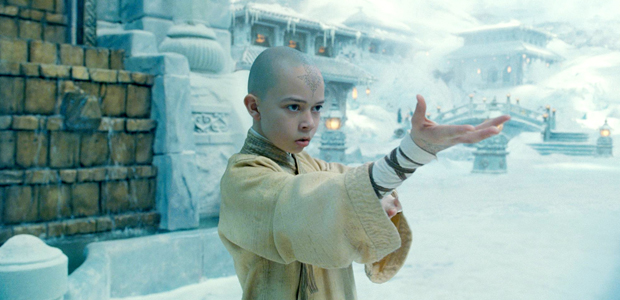
Finding himself far away from rural or urban Pennsylvania, Shyamalan saw a change of pace in his attempt to do a tentpole / franchise starter. But in the process of seeking faithfulness to its cartoon source material, he seemingly shot himself in the foot, more specifically by trying to condense (what fans will tell you was) a season’s worth of story into a 100-minute film, as well as having to rely on child actors to provide gravitas and the physical dexterity required for action sequences. As a result, he made his first truly dramatically inert film.
Luckily, its action does still show an active (if not emotionally engaged) formalist. His only film other than Unbreakable to be shot in 2.35:1, the wide frame is emphasized for bodies in motion and their corresponding spaces, Shyamalan knowing exactly when his camera needs to be still and when it needs to be mobile. As well, a strongly considered blend of modern, CGI-enhanced action with Shaw Brothers classicism, using element-“bending” effects to only punctuate the martial arts choreography.
But, overall, following a string of such extremely risky films, The Last Airbender especially feels like a disappointment. Its worst sin is how seemingly impersonal the whole enterprise is, willing to rest on its visual splendours rather than when, in his previous films, they could fill in an emotional blank that his script couldn’t.
Not only that, but the mythology would seem to lend itself to Shyamalan, the mystical played with a straight face. Unfortunately, it can never really settle down, only continuing to hit a series of marks.
What is your favorite Shyamalan film? Do you agree with our reevaluation of faith & belief in his works?

